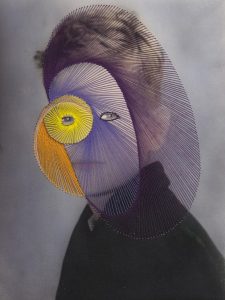Maurizio Anzeri
In October I visited the Saatchi Gallery to see Maurizio Anzeri’s exhibition. Anzeri creates portraits by taking old vintage photographs and sewing directly onto them creating colourful patterns around the black and white or sepia toned photographs. I feel these patterns suggest almost a psychological aura, and are revealing the persons emotions and deeper thoughts.
My favourite piece of the exhibition was ‘Giovanni’ (2009) as I feel this piece especially showed this suggestion of revealing his deeper thoughts. The bright yellow spiral starts from his eye and gets darker, to orange, then darkens further to shades
of blue and purple as it spirals out and spreads around his face and head as if what he is seeing is affecting him emotionally, creating dark or sad thoughts in his head.
Anzeri’s use of vintage antique photographs and the sharp, bold lines and the shimmer of the thread creates a powerful contrast. I feel seeing this photograph in the ‘flesh’ the contrast is so much more effective as there are so many elements to the pictures that you can only really experience when viewing the pieces first hand. When I went to the exhibition I was drawn to go right up close to the photographs in order to see the intricacy and detail which goes into each individual stitch. This, for me, created a new feeling of intimacy between me and the work, that I hadn’t experienced before when just seeing photographs of the pieces, this was due to how close I was to the work and how much attention I therefore paid to it.
In ‘Ways of Seeing’ by John Berger he explains that art has lost its essence through reproduction, that artworks lose elements such as their materiality. Reproduction (photographs) just create a flat, digital image of the artwork, you can no longer or it’s much harder to see and experience the artists brushstrokes, the textures and the shadows of the material in the original pieces. I feel this is true, especially in Anzeri’s work. In real life you are able to see the different gradients, shadows and textures the thread creates. You are able to go up close to the pieces to see the intricacy and detail that goes into each individual line and stitch. You can experience and realise the delicacy of each work through seeing every tiny hole that the thread goes through and the complexity of the process of piercing and threading through each and every one. In real life you want to touch and run your fingers along the thread, you want to involve yourself with the art. Therefore I do feel John Berger is right, experiencing the materiality first hand is so much more effective as it makes the art so much more inviting to the viewer.

